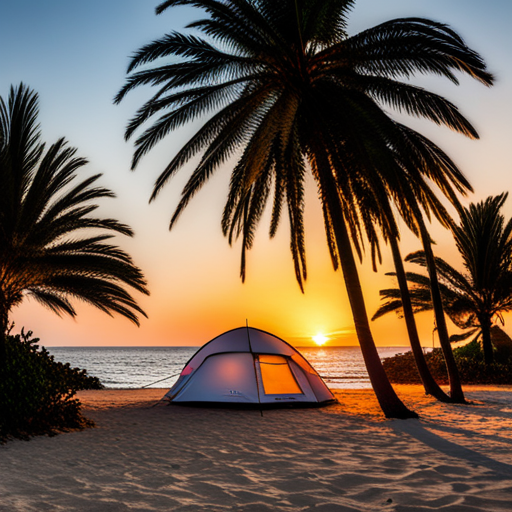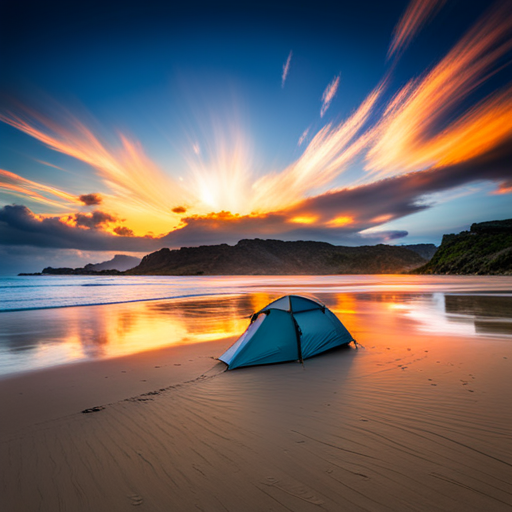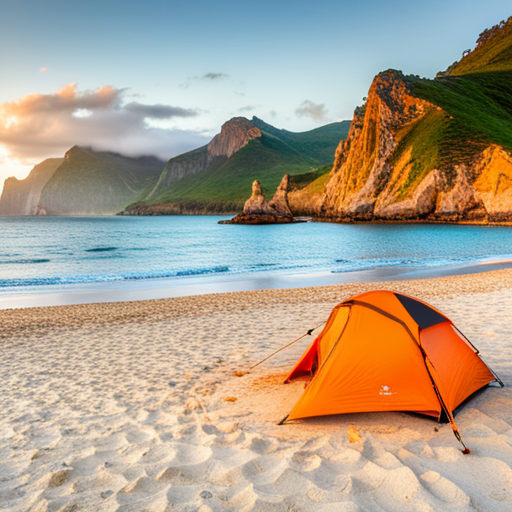Have you ever fantasized about the freedom of beach camping? The thought of setting up your tent on the sandy shores, with the calming sound of the ocean in the background, is quite appealing. However, the actual process of pitching a tent on the beach is not as easy as it sounds. This makes me wonder: How can one establish a perfect beach campsite?
So, how can you set up your tent while camping on the beach? Here are seven easy steps: choosing the right location, securing your tent with stakes or sandbags, and several others. These guidelines will help you create the perfect beach campsite, ensuring a comfortable and enjoyable experience.
In this piece, I’ll go over each step in detail to help you embrace the beauty of nature while camping on the sandy shores. I’ll also provide additional tips to make your beach camping experience even more memorable. So grab your gear and get ready to explore the joys of beach camping – you won’t be disappointed. Let’s dive into it!
Key Takeaways
– Choose a location away from high tide zones and potential hazards, considering wind direction and airflow for a pleasant camping experience.
– Anchor your tent in the sand using sandbags, rocks, or alternative solutions to prevent it from getting blown away.
– Use sandbags for stability by placing rocks on top or filling them with sand or water if rocks are not available.
– Dig trenches around the perimeter of your tent to prevent water pooling, provide added stability against strong winds, and reinforce the tent.
Choosing the Right Location

To ensure a successful beach camping experience, you should choose the right location that provides both safety and convenience. Finding the perfect beach campsite is crucial for a memorable trip. Look for a spot that is away from high tide zones and potential hazards like cliffs or rock formations. It’s important to consider the wind direction as well, as gusts of wind can make your camping experience unpleasant.
When setting up your tent, proper ventilation is key. Choose a location that allows for good airflow, as this will help prevent condensation and keep the inside of your tent dry. Look for a spot with some shade, but make sure it’s not too close to trees or bushes that could drop debris onto your tent.
Another factor to consider when choosing a location is proximity to amenities. Are there bathrooms nearby? Is there a water source for drinking and cleaning? These are important factors to think about for your convenience.
Anchoring Your Tent in the Sand

When setting up your tent on the sandy beach, it’s important to note that tent stakes won’t work effectively in this type of terrain. Instead, opt for using sandbags to provide stability and prevent your tent from getting blown away by strong winds.
Another useful technique is digging trenches around the perimeter of your tent, which will help anchor it and provide additional support.
Tent Stakes Won’t Work
If you’re camping on the beach, the tent stakes won’t work due to the sandy ground. But don’t worry, there are alternative solutions to anchor your tent securely in the sand. Here are some beach camping essentials that will help you set up your tent without relying on traditional tent stakes:
| Alternative Solutions | Pros | Cons |
|---|---|---|
| Sandbags | Easy to fill with sand and provide stability | Can be bulky and heavy to transport |
| Rocks or boulders | Readily available on the beach and provide weight | May not be as secure as other options |
| Parachute cord and sand anchors | Lightweight and easy to carry | Requires more time and effort to set up |
| Screw-in stakes | Provide better anchoring in the sand | Require a power drill or screwdriver to install |
| Sand anchors or sand screws | Specifically designed for anchoring in sand | May require additional tools for installation |
These alternative solutions will ensure that your tent stays put, giving you the freedom to enjoy your beach camping experience without worrying about your shelter.
Use Sandbags for Stability
Use sandbags to anchor your tent securely in the sandy ground, providing stability and peace of mind during your beach camping trip. The soft, shifting sand can make it challenging to keep your tent in place, but with sandbags, you can ensure that your shelter remains secure.
Here are a few reasons why sandbags are the ideal solution:
– Using rocks for stability: Place rocks on top of the sandbags to provide additional weight and stability, keeping your tent firmly in place even in strong winds.
– Using tent weights for stability: If you don’t have access to rocks, you can use specially designed tent weights that can be filled with sand or water. These weights are portable, easy to use, and provide excellent stability.
– Versatility: Sandbags can be used in various ways, such as securing tent corners, anchoring guy lines, or stabilizing camping furniture.
– Easy to pack: Sandbags are lightweight and can be easily packed in your camping gear without taking up too much space.
– Reusable: Sandbags can be used multiple times, making them a cost-effective and environmentally friendly solution.
Digging Trenches for Support
To create additional support for your tent, dig trenches around the perimeter to help prevent water from pooling and ensure stability during windy conditions.
Digging trenches is a simple yet effective way to anchor your tent securely in the sand. Start by using a small shovel or your hands to dig a trench about six inches deep and wide enough to fit the bottom edges of your tent.
Repeat this process along each side of the tent. The trenches will act as barriers, preventing water from accumulating around your tent and giving it added stability against strong winds.
Make sure to pack the sand tightly around the edges of the tent to reinforce its position. By taking this extra step, you can relax and enjoy your beach camping experience with peace of mind.
Setting Up the Tent Frame

When setting up your tent frame, there are a few key points to keep in mind.
First, make sure you have sturdy tent frame essentials, such as durable poles and strong connectors, to ensure the stability of your tent.
Additionally, consider beach-specific frame considerations, like choosing a frame that is resistant to corrosion from sand and saltwater.
Sturdy Tent Frame Essentials
Make sure you’ve got all the necessary essentials for a sturdy tent frame on the beach. Here are some beach tent accessories that will help you maintain your tent frame and ensure a secure setup:
– Tent Stakes: These will anchor your tent to the ground and prevent it from blowing away in strong winds.
– Guy Lines: Attach these lines to your tent and secure them to nearby objects, such as rocks or trees, to provide extra stability.
– Sand Anchors: These specialized stakes are designed to dig deep into the sand, providing a solid hold for your tent.
– Tent Pole Repair Kit: In case of any damage to your tent poles, this kit will come in handy for quick repairs on the go.
– Tent Footprint: A footprint acts as a protective layer between the tent and the ground, preventing wear and tear.
Having these essentials will ensure that your tent frame remains stable and secure, allowing you to enjoy your beach camping experience to the fullest.
Beach-Specific Frame Considerations
Ensure that the frame of your tent is suitable for beach conditions by considering factors such as wind resistance and durability.
When choosing a tent for the beach, opt for beach-specific tent features that can withstand the harsh coastal elements. Look for a tent with a sturdy aluminum or fiberglass frame that is lightweight yet strong. These materials are resistant to corrosion and can handle the strong winds often found at the beach.
Additionally, make sure the tent has reinforced stitching and strong zippers to ensure its durability. To maintain your tent’s performance, regularly clean off sand and saltwater residue, as they can cause damage over time. Store your tent in a cool, dry place to prevent mold and mildew growth.
Quick Assembly Tips
To quickly set up your tent, start by laying out the tent body and attaching the rainfly. This will provide a solid foundation for the rest of the setup process.
Here are some quick setup techniques to make your tent assembly more efficient:
– Use color-coded poles and clips for easy identification and assembly.
– Utilize quick-release buckles and adjustable tension straps for a secure and hassle-free setup.
– Opt for a freestanding tent design that doesn’t require stakes for stability.
– Consider using a footprint or groundsheet to protect the tent floor and make cleanup easier.
– Familiarize yourself with the tent setup instructions before your trip to save time and avoid any confusion.
Securing the Tent With Stakes or Sandbags

First, grab the stakes or sandbags and firmly anchor your tent to prevent it from being blown away by strong winds. When camping on the beach, securing your tent is crucial to ensure a safe and enjoyable experience. If you don’t have stakes, don’t worry – rocks can work just as well. Look for large, heavy rocks that you can use to anchor the corners of your tent. Make sure they are securely placed and won’t easily move.
Alternatively, if you have sandbags, they can provide excellent stability. Fill the sandbags with sand and place them strategically around the base of your tent. This will add weight and prevent the tent from shifting or blowing away in windy conditions. Make sure to position the sandbags evenly to distribute the weight and keep the tent stable.
Remember to secure all the guy lines of your tent as well. These are the ropes that extend from the tent and are attached to the stakes or sandbags. Tighten them properly to provide extra stability and prevent any movement.
Creating a Windbreak or Privacy Shield

Now that you have secured your tent with stakes or sandbags, let’s move on to the next step: creating a windbreak or privacy shield.
When camping on the beach, it’s important to have some protection from the elements and maintain your privacy. Here are some practical ways to achieve this:
– Build a sand wall: Use the sand around you to create a barrier against the wind. Build a low wall around your tent to block the gusts and provide some shelter.
– Set up a windbreak: If you have brought along a large tarp or a beach umbrella, position it strategically to block the wind. This will create a more comfortable space inside your tent.
– Use natural obstacles: Look for natural features like rocks or dunes that can act as a windbreak. Position your tent close to these obstacles to minimize the impact of strong winds.
– Hang a privacy screen: If you value your privacy, hang a lightweight privacy screen around your tent. This will give you a secluded space to relax and enjoy your time on the beach.
– Maintain tent cleanliness: Keep your tent clean and free from sand by using a small broom or brush to sweep away any debris. This will help prevent sand from getting into your sleeping area and keep your tent in good condition.
By following these tips, you can create a comfortable and protected camping experience on the beach.
Now, let’s move on to the next subtopic: maintaining tent cleanliness.
Setting Up a Shade Canopy or Tarp

When setting up a shade canopy or tarp, make sure to choose a location that provides ample coverage from the sun. The beach can be a beautiful place to relax and enjoy the freedom of the outdoors, but the sun can be relentless.
To protect yourself and your belongings, it’s important to select the right shade fabric for your canopy or tarp. Look for a fabric that offers a high level of UV protection and is durable enough to withstand the beach environment.
Once you have your shade fabric, secure the tarp using bungee cords. Bungee cords are excellent for creating tension and keeping the tarp in place, even in windy conditions. Attach one end of the bungee cord to the tarp and the other end to a sturdy anchor point, such as a tent stake or a sandbag. Make sure the tension is tight enough to keep the tarp from sagging or blowing away.
With the right shade fabric and secure attachments, you can enjoy a cool and shaded oasis on the beach, giving you the freedom to relax and enjoy your time outdoors.
Organizing the Interior of Your Beach Campsite

To keep your beach campsite organized, consider using storage bins or crates to store your belongings and keep them off the ground. This will not only help you find what you need more easily, but also keep your items protected from sand and water. Here are some camping hacks for organizing the interior of your beach campsite:
– Label your storage bins: Use waterproof labels to easily identify the contents of each bin. This will save you time and effort when searching for specific items.
– Create designated areas: Assign specific bins or areas for different categories of items, such as cooking utensils, toiletries, or beach toys. This will help you maintain order and prevent clutter.
– Utilize hanging storage: Hang collapsible organizers or shoe organizers inside your tent or nearby trees to maximize vertical space. This is especially useful for storing smaller items like sunscreen, insect repellent, or flashlights.
– Invest in waterproof bags: Keep your clothes and other essentials dry by using waterproof bags or compression sacks. These are great for protecting your belongings from any unexpected rain or splashes.
– Use stackable containers: Opt for stackable containers to make the most of limited space. These can be easily stored inside your tent or vehicle and will keep your items organized and easily accessible.
Following these interior design tips and camping hacks will help you create a well-organized and functional beach campsite, allowing you to fully enjoy your outdoor adventure with the freedom you desire.
Frequently Asked Questions
How Do I Protect My Tent From the Saltwater and Sand at the Beach?
To protect your tent from saltwater and sand at the beach, make sure to choose a tent with waterproof and sand-resistant materials. Additionally, use a groundsheet or tarp underneath the tent for added protection.
Are There Any Specific Regulations or Permits Required for Camping on the Beach?
Before setting up your tent on the beach, it’s important to be aware of any regulations for beach camping and check if any permits are required. This ensures a hassle-free and enjoyable experience.
What Should I Do if I Encounter Wildlife or Insects at the Beach While Camping?
If you encounter wildlife or insects at the beach while camping, stay calm and slowly back away. Avoid sudden movements or loud noises that may startle them. Keep your food properly stored to minimize their attraction.
Are There Any Specific Safety Precautions I Should Take When Setting up a Tent on the Beach?
When setting up your tent on the beach, it’s important to take specific safety precautions. Pay attention to the terrain, secure your tent properly, and anchor it in the sand to ensure stability.
How Can I Ensure That My Tent Stays Cool and Well-Ventilated in the Hot Beach Weather?
To keep your beach tent cool and well-ventilated, follow these tips: 1) Choose a tent with mesh windows for airflow. 2) Position the tent to catch the breeze. 3) Use a portable fan if needed.
Conclusion
So there you have it, seven practical and detailed ways to set up your tent when camping on the beach.
1. Choose the right location.
2. Anchor your tent in the sand.
3. Set up the tent frame.
4. Secure it with stakes or sandbags.
5. Create a windbreak or privacy shield.
6. Set up a shade canopy or tarp.
7. Organize the interior of your beach campsite.
By following these steps, you’ll be well-prepared for a comfortable and enjoyable camping experience.
Now it’s time to hit the beach and start camping!

